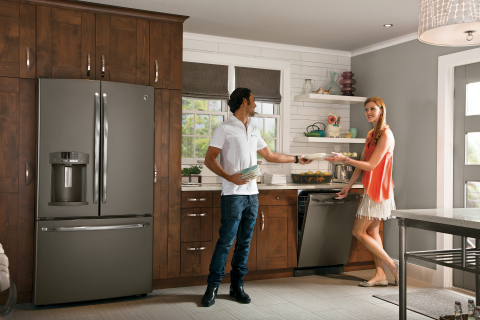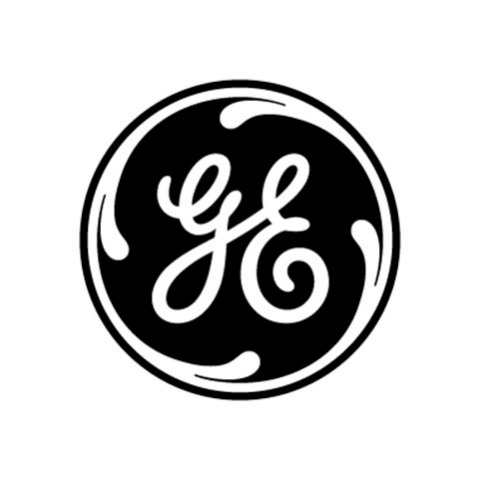LOUISVILLE, Ky.--(BUSINESS WIRE)--Appliance trends may have more staying power than the latest fashion craze, with some like stainless steel appliances, hovering at the top for about 20 years.
But two decades of overwhelming popularity doesn't come with a guarantee. Companies such as GE (NYSE: GE) keep a close watch on consumers and design appliances that make their lives easier, if not enhance them. Whether listening to consumers' preferences on finish, design, energy efficiency or technology, GE Appliances has noticed some shifting in the way consumers want their appliances to look and how they choose to interact with them.
Here are six trends gaining momentum in home appliances.
1. Color – Stainless steel faces competition
While stainless steel is still considered the premium finish for home appliances, accounting for 35 percent* of the kitchen appliances sold today, GE's consumer research found a significant portion of homeowners are looking for something different.
In response to the research, GE launched its new Slate finish, a warm, grey, low-gloss metallic hue. “After introducing the new Slate finish in the third quarter of 2012, we have more than doubled our initial sales goals,” said Brian McWaters, brand general manager for GE Appliances.GE is doubling its Slate product offerings in 2013 with additional refrigeration and cooking models.
2. Design – Traditional is so last year
A National Kitchen and Bath Association's survey found that, for the first time since it began tracking annual design trends, "traditional" is no longer the most popular type of design. The survey determined that, in kitchens and bathrooms, "transitional" is now the most common style.1
Transitional style blends traditional and contemporary to create a modern, classic look with simpler lines than traditional but a more elaborate style than contemporary.1 In summer of 2013, GE launched a new appearance for its GE® and GE Profile™ appliances to complement this trend.
3. Connectivity – Steve Jobs' prediction proving true
In 2007, Steve Jobs, former CEO of Apple Inc., proclaimed the phone was not just a communication tool but a way of life. Just five years later, a Google study found that 26 percent of U.S. smartphone owners would rather give up their computer than their smartphone.2
Responding to this new and connected way of life, GE is revolutionizing smart appliances. For example, the new GE wall ovens have remote connectivity to notify consumers via smartphone when their food is ready. An iPhone® and Android™ app lets consumers control the ovens with Wi-Fi technology.
4. American-made
According to a May 2013 Gallup Poll, six in 10 Americans said they would pay more for an American-made product. Luckily, they may not have to. As labor costs in China continue to increase, more and more companies are bringing manufacturing back to the U.S.3
In 2011, GE made a commitment to invest $1 billion through 2014 to revitalize its U.S. appliances business. Since that promise, GE has launched a frontload laundry pair, GE Café™ French door refrigerator with hot water dispenser, topload washers, a new dishwasher and the GeoSpring™ hybrid electric water heater in the U.S. to name a few.
5. Ergonomically friendly – Appliances adapt to aging population
The older population, persons 65 years or older, numbered 39.6 million in 2009. They represented 12.9 percent of the U.S. population or about one in every eight Americans. By 2030, there will be about 72.1 million older persons.4 This population is having an influence on appliance design.
With range of motion declining as age increases, GE recently introduced its frontload laundry pair which helps reduce the strain of loading and unloading the washing machine. GE engineers and industrial designers built the washer and dryer for every body using universal design principles. The GE® RightHeight™ Design frontload washer and dryer incorporate the industry's largest openings and the first Built-in Riser™ to minimize strenuous bends and long reaches.
6. Illumination – LED winning over other light sources
Energy-efficient LEDs are surging in popularity while compact fluorescent lights are waning in their widespread appeal. According to a National Bath and Kitchen Association survey in 2012, 70 percent of kitchen designers specified LED lighting.1
From grills to refrigerators, GE marries its innovations in lighting and appliances by introducing products with LED lights, such as the GE Café French door refrigerator, that has colored LED lights in the drawers as visual cues of the temperature chosen. Industry-first notification lighting can be found on GE's latest wall ovens.
Consumer preferences are always changing and appliance trends will continue to keep up thanks to manufacturers, such as GE, that constantly consider what's next.
*Taken from the 2011 Association of Home Appliance Manufacturers Color Report.
1. “Transitional Replaces Traditional in Kitchen Design.” ApplianceMagazine.com. February 2012. Accessed on May 31, 2013. http://www.appliancemagazine.com/editorial.php?article=2423
2. Goldman, David. “Half of U.S. cell phones are now smartphones.” CNN Money. May 16, 2012. Accessed on May 30, 2013. http://money.cnn.com/2012/05/16/technology/smartphones/index.htm
3. Sirkin, Harold L., Michael Zinser, and Douglas Hohner. Made in America, Again. The Boston Consulting Group. August 2011. Accessed on May 30, 2013.https://www.bcgperspectives.com/Images/made_in_america_again_tcm80-84471.pdf
4. http://www.aoa.gov/Aging_Statistics/ (the latest year for which data is available).
GE Appliances
GE Appliances is at the forefront of building innovative, energy-efficient appliances that improve people’s lives. GE Appliances’ products include refrigerators, freezers, cooking products, dishwashers, washers, dryers, air conditioners, water filtration systems and water heaters. General Electric (NYSE: GE) works on things that matter to build a world that works better. For more information on GE Appliances, visit www.ge.com/appliances.




